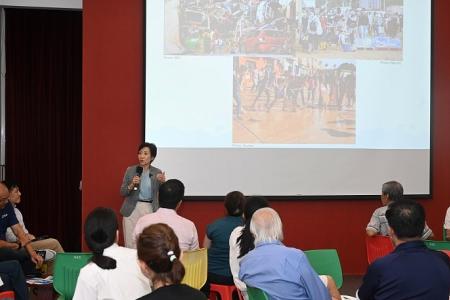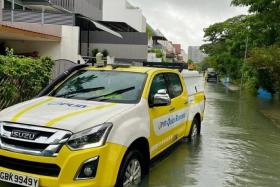Singapore's east-siders discuss flood preparations
In mid-September, a 4am thunderstorm and strong winds snapped a yacht’s mooring line at Changi Sailing Club while the vessel’s owner was asleep aboard.
Fortunately, a second line stopped the yacht from drifting out to sea, providing sufficient time for emergency action to be taken, and preventing the vessel from hitting others next to it, said Mr Choy Yi Hong, general manager of the sailing club.
Three years ago, before the club’s drainage system was improved, continuous heavy rain led to ankle-deep flooding of the club’s boatyard.
Mr Choy said he is bracing himself for future extreme weather caused by climate change that may impact the club in future.
He was among more than 50 residents and business owners of Singapore’s east region who gathered at Victoria Junior College (VJC) on Nov 5 to discuss how to prepare for floods, as the north-east monsoon season and rainy La Nina climate phenomenon approach.
Upper East Coast Road and Bedok South Road are among the around 30ha of flood-prone areas islandwide, which also include Beach Road and the Jalan Besar area. Drainage improvements and other measures since the 1970s have reduced such areas, which used to total 3,200ha.
Mr Darren Lew, senior principal engineer at PUB’s catchment and waterways department, said that while Singapore has been investing in drainage upgrading projects over the years, climate change will bring heavier, more intense and frequent storms.
“But we also know that we cannot indefinitely expand, widen or deepen our drains due to space constraints. Therefore, it is very crucial for us to strengthen Singapore’s community flood resilience. The community and businesses need to be aware of flood risks. They need to be ready,” he said.
Over the two-hour session, also attended by Minister for Sustainability and the Environment Grace Fu, the participants discussed ways to respond during floods.
At the session, Ms Fu showed the participants photos and news footage of Taiwan’s Typhoon Kong-rey and the recent Spain floods that have killed more than 200 people.
She asked the participants: “When (flooding) does happen, how do we ensure that basic infrastructure continues? How do we ensure we get back to business as quickly as we can? The community can offer emotional support so that they can recover physically and emotionally.”
Suggestions included setting up evacuation routes in neighbourhoods, having emergency survival kits at home, and using community centres as holding areas.
Observing that the clusters of houses opposite VJC have narrow roads that can be submerged during floods, Siglap resident Reginald Thio, 46, suggested deploying vehicles that run both on land and water - so that emergency services and groceries can reach residents trapped during a flood.
Much of the East Coast area is also low-lying, making it at risk of future sea level rise and coastal flooding. While flash flood events typically subside within an hour or so here, they can leave destruction in their wake. Over the past two months, Singapore experienced a couple of heavy thunderstorms and flash flood incidents.
On Sept 17, a strong Sumatra squall affected more than 300 trees islandwide, dumped intense rain and even damaged a glass canopy outside UOB Plaza.
In Yishun, an SBS Transit bus captain and passenger were taken to hospital after a tree fell on the bus.
On the morning of Oct 14, the western part of Singapore saw one of the heaviest downpours in over 40 years. The prolonged rain which started after midnight that day resulted in flooding in many areas, such as Tampines, Bukit Timah and Dunearn Road, with videos on social media showing vehicles moving through flooded roads.
The north-east monsoon is expected to start in late November or early December. Every year before the monsoon, PUB would distribute flood protection gear to homes and businesses in flood-prone zones and hot spots. Those items include inflatable flood bags and various flood barriers.
To date, around 16,000 of such items have been distributed, and PUB is currently distributing 800 more. In mid-November, the agency will roll out a campaign on flood resilience.
This session, organised by national water agency PUB, was the first exercise on climate impacts that a government agency has held with members of the public. It was held in collaboration with Nexus, the national education arm of the Ministry of Defence, and non-profit Women in Sustainability and Environment.
Get The New Paper on your phone with the free TNP app. Download from the Apple App Store or Google Play Store now


